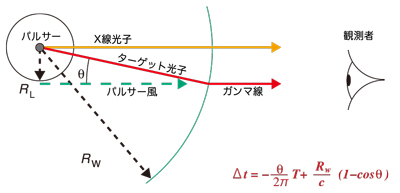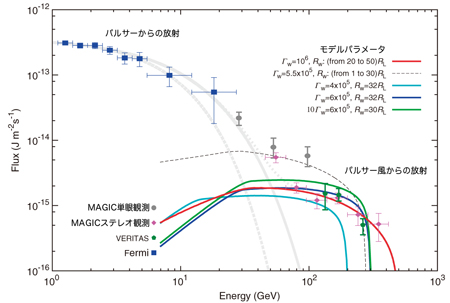TOP > Report & Column > The Forefront of Space Science > 2012 > When Nature does Physics a favour
![]()

However, there is an important property of the wind signal that helps to make its detection possible: the wind signal is expected to be pulsed. This is related to the fact that in the case of the Crab pulsar, the flux of the pulsed target photon field, which is produced in the pulsar magnetosphere, is dominant. As it is illustrated in Figure 2, the time profile of the target photon field should be preserved in the gamma-ray signal of the wind. This fact allows the wind emission to be differentiated from the dominant emission produced in the nebula. Moreover, since the spectrum and fluxes of the Crab pulsar are well measured, the expected wind signal depends only on two unknown parameters - the distance to the site of the wind formation and the wind bulk Lorentz factor (see Figure 2). Importantly, the spectral shape of the wind signal appeared to be quite distinct, clearly distinguishable from the magnetospheric emission. 
Recently, a pulsed very high energy signal from the Crab pulsar was reported by two Čerenkov collaborations, MAGIC and Veritas. The measured spectrum can be naturally interpreted as the signal produced by the pulsar wind (see Figure 3), allowing its properties to be measured with unprecedented precision. Surprisingly, the obtained results imply not only that the wind properties perfectly match to the idealEmodel suggested more than 25 years ago, but also that the Crab pulsar wind converges to the state predicted by this model very rapidly, almost instantly (at a distance equal to 1/1,000,000,000 of the nebula size). This is a unique case when a very complicated phenomena gets an unexpectedly good description in the framework of the simplest model. 
Dmitry Khangulyan
|
||||||||||




